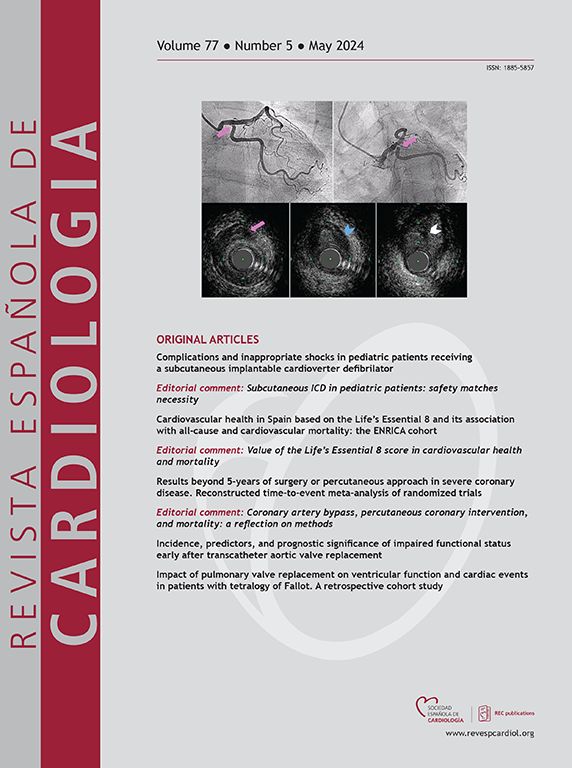高级超声心动图和聚类分析,以识别具有不同风险的继发性三足功能不全的表型群
IF 5.9
2区 医学
Q2 Medicine
引用次数: 0
摘要
重要的继发性三尖瓣反流(STR)与不良预后相关,但其异质性使得预测患者预后具有挑战性。我们的目的是确定STR预后表型。方法对758例中重度STR患者进行分析:衍生队列558例(74±14岁,55%为女性),外部验证队列200例(73±12岁,60%为女性)。主要终点是心力衰竭住院和全因死亡率的综合。结果共鉴定出3个表型组。低风险表型组(2年无事件生存率80%,95%CI, 74%-87%)有中度STR,保留右心室(RV)大小和功能,中度扩张但功能正常的右心房。中危表型组(HR, 2.20; 95%CI, 1.44-3.37; P < .001)包括严重STR的老年患者和轻度扩张但未耦合的RV。高危表型组(HR, 4.67; 95%CI, 3.20-6.82; P < .001)包括年轻的三尖瓣大量到剧烈反流的患者,以及严重扩张和功能不全的右心室和右心房。多变量分析证实聚类与复合终点独立相关(HR, 1.40; 95%CI, 1.13-1.70; P = 0.002)。为了帮助临床医生将患者分配到3个表型组,开发了一个监督机器学习模型,该模型在衍生队列(准确性= 0.91,精度= 0.91,召回率= 0.91,F1评分= 0.91)和验证队列(准确性= 0.80,精度= 0.78,召回率= 0.78,F1评分= 0.77)中都表现出色。结论无监督聚类分析确定了3个风险表型,有助于临床医生为STR患者制定更个性化的治疗和随访策略。本文章由计算机程序翻译,如有差异,请以英文原文为准。
Ecocardiografía avanzada y análisis de conglomerados para identificar fenogrupos de insuficiencia tricuspídea secundaria con diferente riesgo
Introduction and objectives
Significant secondary tricuspid regurgitation (STR) is associated with poor prognosis, but its heterogeneity makes predicting patient outcomes challenging. Our objective was to identify STR prognostic phenogroups.
Methods
We analyzed 758 patients with moderate-to-severe STR: 558 (74 ± 14 years, 55% women) in the derivation cohort and 200 (73 ± 12 years, 60% women) in the external validation cohort. The primary endpoint was a composite of heart failure hospitalization and all-cause mortality.
Results
We identified 3 phenogroups. The low-risk phenogroup (2-year event-free survival 80%, 95%CI, 74%-87%) had moderate STR, preserved right ventricular (RV) size and function, and a moderately dilated but normally functioning right atrium. The intermediate-risk phenogroup (HR, 2.20; 95%CI, 1.44-3.37; P < .001) included older patients with severe STR, and a mildly dilated but uncoupled RV. The high-risk phenogroup (HR, 4.67; 95%CI, 3.20-6.82; P < .001) included younger patients with massive-to-torrential tricuspid regurgitation, as well as severely dilated and dysfunctional RV and right atrium. Multivariable analysis confirmed the clustering as independently associated with the composite endpoint (HR, 1.40; 95%CI, 1.13-1.70; P = .002). A supervised machine learning model, developed to assist clinicians in assigning patients to the 3 phenogroups, demonstrated excellent performance both in the derivation cohort (accuracy = 0.91, precision = 0.91, recall = 0.91, and F1 score = 0.91) and in the validation cohort (accuracy = 0.80, precision = 0.78, recall = 0.78, and F1 score = 0.77).
Conclusions
The unsupervised cluster analysis identified 3 risk phenogroups, which could assist clinicians in developing more personalized treatment and follow-up strategies for STR patients.
求助全文
通过发布文献求助,成功后即可免费获取论文全文。
去求助
来源期刊

Revista espanola de cardiologia
医学-心血管系统
CiteScore
4.20
自引率
13.60%
发文量
257
审稿时长
28 days
期刊介绍:
Revista Española de Cardiología, Revista bilingüe científica internacional, dedicada a las enfermedades cardiovasculares, es la publicación oficial de la Sociedad Española de Cardiología.
 求助内容:
求助内容: 应助结果提醒方式:
应助结果提醒方式:


